
Yeomanry is a designation used by a number of units and sub-units in the British Army Reserve which are descended from volunteer cavalry regiments that now serve in a variety of different roles.
Sir Morris Ximenes (1762–1837), also known as Moses Ximenes, was a captain in the British Army and Berkshire landowner who had converted to Anglicanism from Judaism.
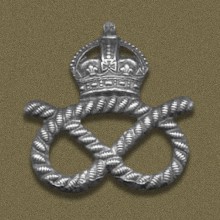
The Staffordshire Yeomanry (Queen's Own Royal Regiment) was a mounted auxiliary unit of the British Army raised in 1794 to defend Great Britain from foreign invasion. It continued in service after the Napoleonic Wars, frequently being called out in support of the civil powers. It first sent units overseas at the time of the Second Boer War and saw distinguished service in Egypt and Palestine in World War I. During World War II it gave up its horses and became a tank regiment, serving in the Western Desert and landing in Normandy on D-Day. Postwar the Staffordshire Yeomanry became part of the Queen's Own Mercian Yeomanry with one of the squadrons being designated 'Staffordshire Yeomanry' until 2021.

The Berkshire Yeomanry was a part time regiment of the British Army formed in 1794 to counter the threat of invasion during the French Revolutionary Wars. It was the Royal County of Berkshire's senior volunteer unit with over 200 years of voluntary military service. After taking part in the Second Boer War, it saw action as mounted troops in the First World War and as artillery in the Second World War. Its lineage is maintained by 94 Signal Squadron, part of 39 (Skinners) Signal Regiment. The Headquarters of the Squadron is based in Windsor, Berkshire. The Berkshire Yeomanry had a number of battle honours won from Europe to the Far East and Private Frederick Potts was awarded a Victoria Cross for service during the Gallipoli Campaign.
The Royal Berkshire Militia was an auxiliary military regiment in the county of Berkshire in Southern England. From their formal organisation as Trained Bands, in 1572 and their service during the Armada Crisis and in the English Civil War, the Militia of Berkshire served during times of international tension and all of Britain's major wars. The regiment provided internal security and home defence but sometimes operated further afield, relieving regular troops from routine garrison duties and acting as a source of trained officers and men for the Regular Army. It later became a battalion of the Royal Berkshire Regiment, and prepared thousands of reinforcements for the fighting battalions of the regiment in World War I. After 1921 the militia had only a shadowy existence until its final abolition in 1953.

The Duke of Lancaster's Own Yeomanry (DLOY) was a yeomanry unit of the British Army from 1798 to 1992. Originally raised as part-time cavalry for home defence and internal security, the regiment sent mounted infantry to serve in the Second Boer War. During World War I it carried out mounted duties in Egypt and Palestine and on the Western Front. By 1917 the reserve units at home had become cyclists and the regiment serving on the Western Front joined an infantry battalion, seeing action at the Battle of Passchendaele, against the German Spring Offensive and in the final Allied Hundred Days Offensive. At the beginning of World War II the regiment gave up its horses and formed two regiments of medium artillery, which served in the Middle East, Italy and North West Europe. Postwar it became an armoured unit. Today its lineage is maintained by B Squadron, the Queen's Own Yeomanry.

The Queen's Own Worcestershire Hussars was a Yeomanry regiment of the British Army. First raised in 1794, it participated in the Second Boer War and World War I as horsed cavalry before being converted to an anti-tank regiment of the Royal Artillery for service in World War II. In 1956 it was amalgamated with the Warwickshire Yeomanry to form the Queen's Own Warwickshire and Worcestershire Yeomanry. The lineage is maintained by B Squadron, part of The Royal Yeomanry.
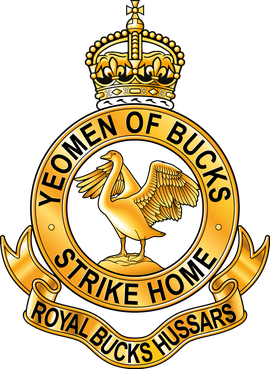
The Royal Buckinghamshire Yeomanry is an Operational Hygiene Squadron of the Royal Logistic Corps, originally formed as cavalry in 1794, and has also served in artillery and signals roles. The lineage is continued by 710 Operational Hygiene Squadron, Royal Logistic Corps.
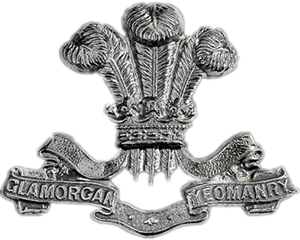
{{Infobox military unit |unit_name=Glamorgan Yeomanry |abbreviation= |image= |caption=Glamorgan Yeomanry cap badge |dates= 1797–1831
1861–1873
1901–present |country = Kingdom of Great Britain (1794–1800)
United Kingdom (1801–Present) |allegiance= |branch= Territorial Army |type=Yeomanry |role= |size= Regiment |command_structure= |equipment= |Past Commanders= |ceremonial_chief= |colonel_of_the_regiment= |notable_commanders=Col Windham Wyndham-Quin |identification_symbol= |identification_symbol_2= |nickname= |patron= |motto= |colors= |march= |mascot= |battles=* Merthyr Rising
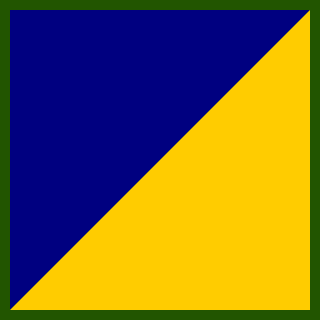
The Pembroke Yeomanry was an auxiliary regiment of the British Army dating back to 1794. It saw active service in the French Revolutionary War, the Second Boer War, World War I and World War II. Its lineage is maintained by 224 Transport Squadron, part of 157 (Welsh) Regiment RLC in the Army Reserve.

The Hampshire Yeomanry was a yeomanry cavalry regiment formed by amalgamating older units raised between 1794 and 1803 during the French Revolutionary Wars. It served in a mounted role in the Second Boer War and World War I, and in the air defence role during and after World War II. The lineage is continued by 295 Battery and 457 Battery, batteries of 106 (Yeomanry) Regiment Royal Artillery, part of the Army Reserve.

The Hertfordshire Yeomanry was a Yeomanry Cavalry regiment of the British Army that could trace its formation to the late 18th century. First seeing mounted service in the Second Boer War and World War I, it subsequently converted to artillery. Three regiments saw service in World War II, one of which was captured at the fall of Singapore. It continued through various postwar amalgamations and its lineage was maintained by 201 Battery, 100th (Yeomanry) Regiment Royal Artillery until that unit was placed in suspended animation in 2014.

The British Militia was the principal military reserve force of the Kingdom of Great Britain. Militia units were repeatedly raised in Great Britain during the Georgian era for internal security duties and to defend against external invasions. The Militia Act 1757, passed by the Parliament of Great Britain after the outbreak of the Seven Years' War, led to the rapid expansion of the British Militia in order to defend from potential French invasions. In the Kingdom of Ireland, a client state of Great Britain, the equivalent force was the Irish Militia, which saw heavy service in the Irish Rebellion of 1798 alongside British militia units. The existence of militia units in Great Britain and Ireland played an important role in freeing regular troops from the British and Irish establishments for overseas service.

The Volunteer Corps was a British voluntary part-time organization for the purpose of home defence in the event of invasion, during the French Revolutionary and Napoleonic Wars.
From the creation of the British Regular Army in 1660, it has been supplemented by part-time volunteer units raised on a local basis. Northamptonshire has often been in the forefront of raising these units, both of horse and foot, whenever circumstances required.
The Militia and Volunteers of County Durham are those military units raised in the County independent of the regular Army. The "modern" militia dates from legislation enacted during the Seven Years' War. The volunteers had several forms and separate periods of existence until made a permanent body in 1859.
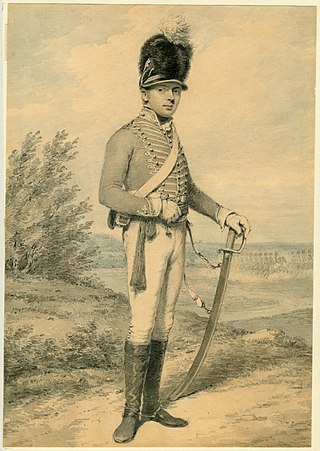
The Provisional Cavalry was a force levied in Great Britain from 1796 for home defence and organised at the county level. The unit was raised by an act of Parliament instigated by the Secretary of State for War Henry Dundas who thought light cavalry would be particularly effective against any invading force. It was filled by means of an obligation from Britain's horse owners, who had to provide one trooper for every ten horses owned – a method which drew comparisons to the feudal system. Each county had a quota of cavalrymen that it was expected to provide. The act was unpopular and the number and quality of recruits was low.
The Staffordshire Militia was an auxiliary military force in Staffordshire in the West Midlands of England. From their formal organisation as Trained Bands in 1572 and their reorganisation in 1662 and 1777, the Militia regiments of Staffordshire served during times of international tension and all of Britain's major wars. They provided internal security and home defence but in the Crimean War were stationed in the Mediterranean relieving regular troops from routine garrison duties. They also acted as a source of trained officers and men for the Regular Army. By the later 19th Century there were four battalions, assigned to the South and North Staffordshire Regiments. All the battalions went on active service during the Second Boer War and all served as Special Reserve training units in World War I, with two battalions seeing considerable action on the Western Front. After 1921 the militia had only a shadowy existence until its final abolition in 1953.
The Montgomeryshire Militia, later the Royal Montgomeryshire Rifles, was an auxiliary regiment reorganised in the Welsh county of Montgomeryshire during the 18th Century from earlier precursor units. Primarily intended for home defence, it served in Great Britain and Ireland during Britain's major wars. It later became part of the South Wales Borderers until it was disbanded in 1908.












